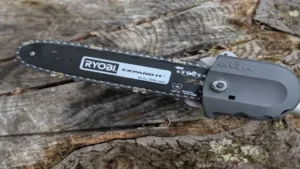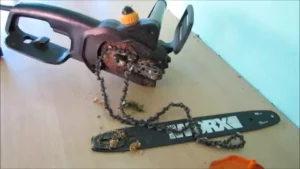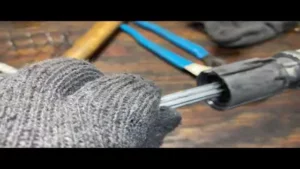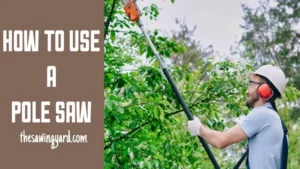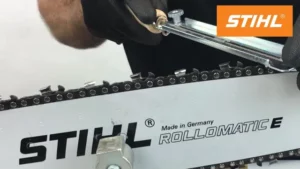Do you have a palm tree in your yard that needs trimming? Are you wondering how you can do it without climbing on a ladder or hiring a professional? Look no further than a pole saw! A pole saw is a versatile tool that can help you trim your palm tree safely and effectively. In this blog, we’ll go over the steps you need to follow to trim your palm tree with a pole saw. We’ll show you how to choose the right pole saw, how to prepare your tree, and how to trim it.
Plus, we’ll provide some tips and tricks to make the job easier. With this guide, you’ll be able to give your palm tree a healthy and attractive look without breaking a sweat!
Choosing the Right Pole Saw
If you’re wondering how to trim a palm tree with a pole saw, the first thing you need to do is choose the right tool for the job. A pole saw is a convenient and practical tool for pruning trees, especially for those hard-to-reach branches. To start, make sure you select a saw with a sturdy build and long reach.
Consider the type of blade, too—the sharper the blade, the cleaner the cut, so you’ll want a saw with a high-quality blade. Additionally, ensure you choose a saw with a comfortable grip, as you don’t want your hands slipping while you’re working above your head. When you’re all set up, start by removing any dead or diseased fronds first, and then work your way upwards.
Remember to take all the necessary safety precautions, such as wearing the proper gear and ensuring the branch you’re about to cut won’t fall on anyone!
Consider the Height of the Tree
When it comes to choosing the right pole saw, it’s essential to consider the height of the tree. Not all pole saws are created equal, and different models come with varying ranges. Investing in a saw with a long enough pole can ensure that you can safely and effectively reach the upper branches of the tree.
If you’re working with taller trees, it’s important to choose a pole saw that has adjustable length options, allowing you to customize the length to match the tree’s height. This is especially important for taller trees that can lead to accidents when not handled carefully. By taking the height of the tree into consideration, you can select a pole saw that makes your gardening tasks safer and easier.
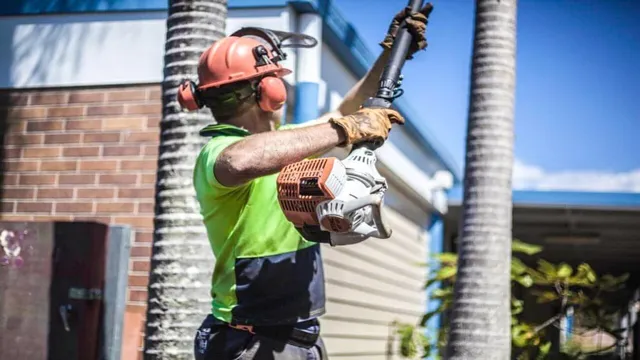
Consider the Thickness of the Branches
When choosing the right pole saw, one of the important factors to consider is the thickness of the branches you will be cutting. Not all pole saws are created equal, and some may not be strong enough for thicker branches. This is why it’s important to check the manufacturer’s specifications to ensure the saw can handle the diameter of the branches you will be working with.
If the blade is not strong enough, it may not be able to cut through the branch cleanly and can even cause damage to the saw. On the other hand, if the blade is too heavy-duty for the task at hand, it can make the tool difficult to handle and may lead to operator fatigue. So, take the time to understand the thickness of the branches you’ll be cutting and choose a pole saw that is appropriate for the job.
Preparation Steps
If you’re looking to trim a palm tree with a pole saw, there are a few preparation steps to keep in mind. First, you’ll want to ensure that you have all the necessary equipment, including a pole saw with a sharp blade, gloves, eye protection, and a ladder or sturdy platform. Next, it’s important to assess the tree and determine which branches need to be trimmed.
Look for dead or damaged branches, as well as those that are growing too close to power lines or buildings. By identifying these areas ahead of time, you’ll be able to work more efficiently and safely. Finally, be sure to check the weather forecast and choose a day with calm conditions.
Wind and rain can make trimming palm trees dangerous and difficult. With these preparation steps in mind, you’ll be able to tackle your palm tree trimming project with confidence using your pole saw.
Safety Measures
As we venture out into our daily lives, it’s important to be prepared for any safety risks that may come our way. One of the most essential preparation steps is to have a safety plan in place. This can include identifying potential hazards in your environment and knowing what to do in case of an emergency.
It’s also important to have a well-stocked emergency kit with items such as first aid supplies, flashlights, and non-perishable food. In addition, it’s crucial to keep up-to-date with current safety guidelines and regulations in your area, as these can change rapidly. By taking these preparation steps, you can greatly reduce the likelihood of harm and ensure that you are ready to handle any safety situation that may arise.
Identify the Branches to be Cut
One of the most important preparation steps when trimming trees is identifying the branches to be cut. This is crucial because it can affect the overall health and appearance of the tree, as well as the safety of those working on it. Before deciding which branches to remove, it’s important to have a clear goal in mind.
For example, some branches may be blocking light or obstructing a pathway, while others may be dead or diseased and need to be removed to prevent further damage to the tree. It’s also important to consider the size and location of the branches, as well as any potential hazards such as power lines or nearby buildings. By carefully evaluating each branch and determining the proper course of action, you can ensure a successful and safe tree trimming project.
Remember to always use proper equipment and techniques to avoid injury or damage to the tree.
Clear the Surrounding Area
When it comes to preparing for a project, it’s important to take the time to clear the surrounding area. This step is often overlooked, but it can make a huge difference in the success and efficiency of the project. By clearing the area, you’re creating a safe and organized workspace that will help you focus on the task at hand.
This means removing any obstacles, clutter, or hazards that could get in the way of your work or cause injury. It’s also important to consider the equipment and materials you’ll be using and ensure that they have enough space to be stored and used properly. By taking the time to clear the area, you’re setting yourself up for a smoother, more productive project that will ultimately lead to better results.
So, before you dive into your next project, make sure to prioritize this important preparation step.
Trimming Techniques
If you’re wondering how to trim a palm tree with a pole saw, there are a few techniques you can use to get the job done safely and effectively. First, you’ll need to assess the tree and determine which fronds or branches need to be removed. Make sure you have a good grip on the pole saw and position yourself in a stable position before starting.
When cutting, begin from the bottom of the frond or branch and work your way up to avoid accidentally cutting off more than necessary. It’s also important to avoid cutting into the trunk or leaving long stubs, as this can lead to disease or pests. Overall, trimming a palm tree with a pole saw requires patience, attention to detail, and a steady hand.
Start at the Bottom of the Tree
When it comes to trimming trees, one of the best techniques is to start at the bottom and work your way up. This ensures that you won’t miss any branches and that you have access to all parts of the tree. By starting at the bottom, you can identify any dead or diseased branches that need to be removed and get rid of them before moving up to the healthier parts of the tree.
This technique also makes it easier to remove any low-hanging branches or those that are in the way of foot traffic. Remember to always use sharp, clean tools when trimming trees, and to make cuts at a slight angle to prevent water from pooling on the branch. By using the bottom-up approach, you’ll be able to give your tree a proper trim that will keep it healthy and looking great for years to come.
Use Smooth, Controlled Cutting Motions
When it comes to trimming your hair, using smooth and controlled cutting motions is essential. This is especially important if you want to achieve a precise and even cut. Avoid using choppy or erratic motions, as this can result in an uneven and jagged cut.
Instead, take your time and use fluid, controlled movements to gradually trim away the desired amount of hair. If you’re using scissors, hold them at a slight angle and take small snips, rather than trying to cut off large chunks at once. This will make it easier to achieve the desired length and texture without damaging your hair.
By following these trimming techniques, you can ensure a professional-looking haircut every time. So, go ahead and give it a try and see the difference it can make.
Cutting Overhead Branches
When it comes to cutting overhead branches, there are a variety of trimming techniques to consider. One popular method is called the three-cut technique, which involves making a notch on the underside of the branch, followed by a cut on the top side a few inches away from the notch. The branch can then be safely removed by making a third and final cut close to the main branch.
Another technique involves making a series of small cuts on the underside of the branch and then making one final cut on the top side to remove the branch completely. Regardless of which technique you choose, it’s important to wear safety gear such as gloves, eye protection, and a hard hat to avoid injury. By using these techniques and taking the necessary safety precautions, it’s possible to efficiently and safely trim overhead branches to maintain your property’s safety and appearance.
Remember to always prioritize safety first and consult a professional if you are unsure about how to properly trim a tree or branch.
Post-Trimming Care
Now that you’ve successfully trimmed your palm tree with a pole saw, it’s important to take care of it properly. The first step is to dispose of the trimmings properly. You can either add them to your compost pile or take them to your local green waste facility.
Next, keep an eye out for any signs of damage or disease. If you notice any brown spots or yellowing leaves, it may be a sign of an underlying issue. Make sure to water your palm tree deeply but infrequently, allowing the soil to dry out slightly before watering again.
Finally, consider applying a slow-release fertilizer to provide your palm tree with essential nutrients. By following these post-trimming care tips, you’ll ensure the health and longevity of your palm tree.
Seal the Cuts with Sealant
After trimming your plants, it is important to seal the cuts with sealant to prevent any infections or pests from entering the plant. Sealant is a useful tool that seals the wounds and promotes faster healing. It acts as a barrier against bacteria, fungi, and other pathogens that might infect the plant.
When applying the sealant, make sure to cover the entire area of the wound and cover it completely. With the application of the sealant, the wound will be protected from any diseases or pests that may threaten the plant’s growth. Use a high-quality sealant to ensure the best results and to prevent the wound from reopening.
Sealing your plant’s cuts with sealant is a necessary step in post-trimming care that will keep the plant healthy and thriving.
Clean Up the Debris
After trimming your trees, it’s essential to clean up the debris to promote healthy growth. If you don’t clean up the leaves, branches, and twigs, they can create a blockage in the growth of new branches. Plants need access to sunlight, water, and nutrients, all of which can be hindered by fallen debris.
Not cleaning up the debris also poses a safety hazard, as it can cause falls and injuries. To properly clean up the debris, gather all the fallen branches, leaves, and twigs and dispose of them properly. You can either compost the leaves and twigs or dispose of them in a recycling or yard waste bin.
Removing debris not only promotes new growth but also keeps your property tidy and safe.
Conclusion
And that, my dear friends, is how you turn a towering palm tree into a well-manicured work of art! Armed with your trusty pole saw and a little know-how, you’ve now got all the tools you need to give your backyard that tropical oasis feel. Just remember to be safe, take your time and never underestimate the power of a well-groomed palm tree. Happy trimming!”
FAQs
What equipment do I need to trim a palm tree with a pole saw?
To trim a palm tree with a pole saw, you will need a pole saw, safety goggles, gloves, and possibly a ladder for taller trees.
How often should I trim my palm tree with a pole saw?
It’s recommended to trim your palm tree once or twice a year. However, the frequency of trimming may depend on the growth rate of your palm tree and its location.
Can I use a regular saw to trim my palm tree instead of a pole saw?
It’s not recommended to use a regular saw to trim a palm tree, as you may not be able to reach all the branches effectively. Using a pole saw will allow you to reach higher branches while maintaining your safety.
What time of year is best to trim a palm tree with a pole saw?
The best time to trim a palm tree with a pole saw is during the dormant season, typically in late winter or early spring. This is when the tree’s growth rate is slowest.
How do I safely trim a palm tree with a pole saw?
To safely trim a palm tree with a pole saw, make sure you wear safety goggles and gloves. Ensure the pole saw is in good condition and stable. Never stand on a ladder to reach high branches, instead, use the pole saw’s extension feature.
How do I know which branches to trim on my palm tree with a pole saw?
You should trim dead or diseased branches, and any branches that are blocking sunlight or growing too close together. Also, trim any branches that are too low and obstructing pedestrian or vehicular traffic.
Can I trim my palm tree myself or should I hire a professional?
If you have experience with trimming trees and feel confident in your abilities, you can trim your palm tree yourself. Otherwise, it’s best to hire a professional to avoid damaging the tree or injuring yourself.

